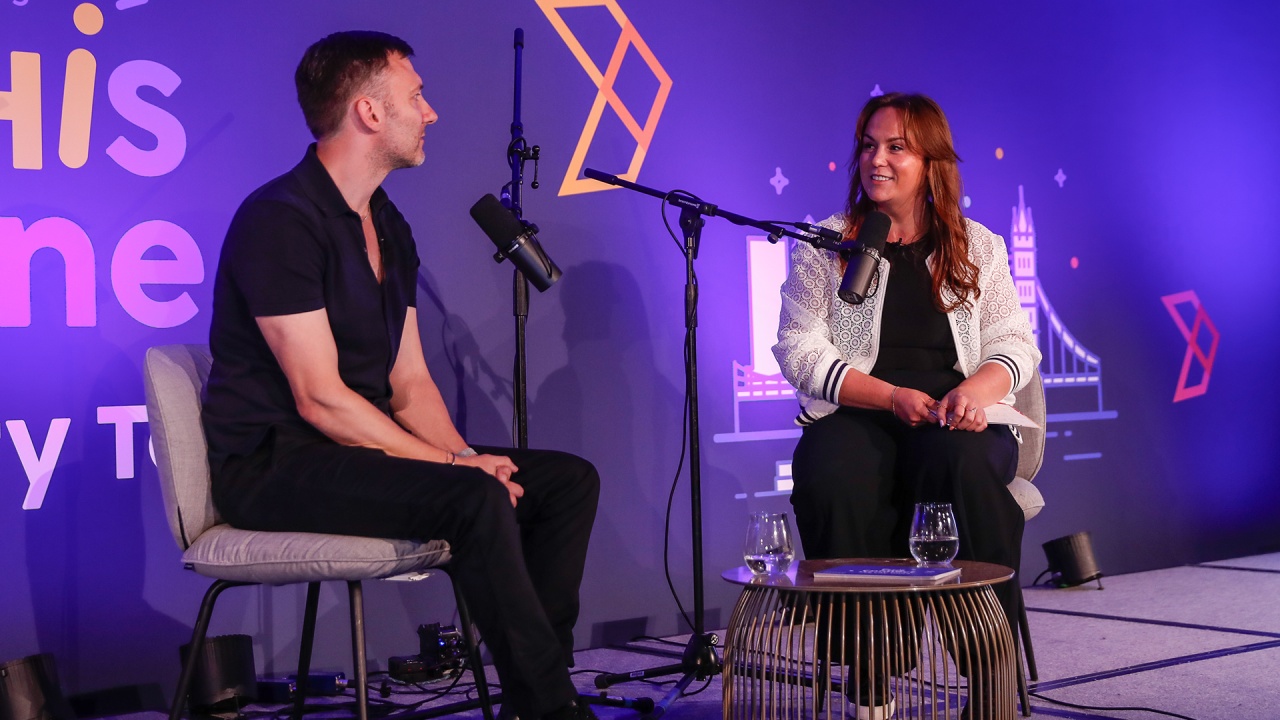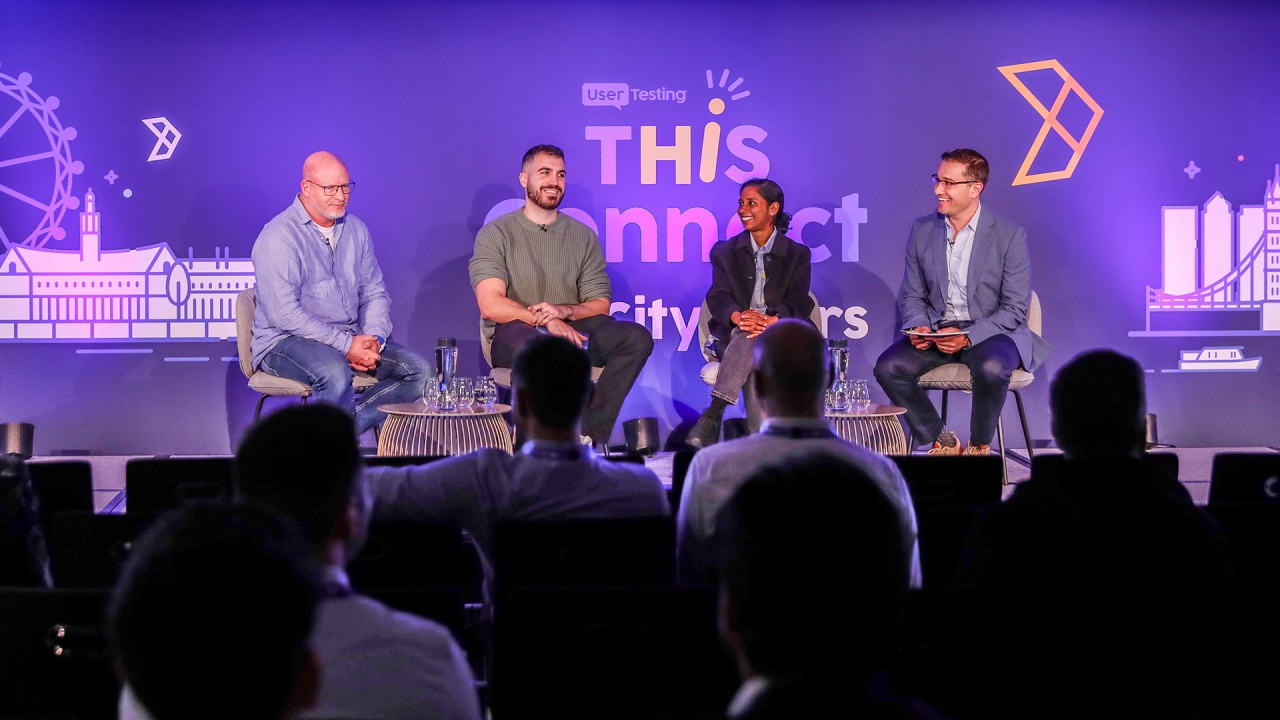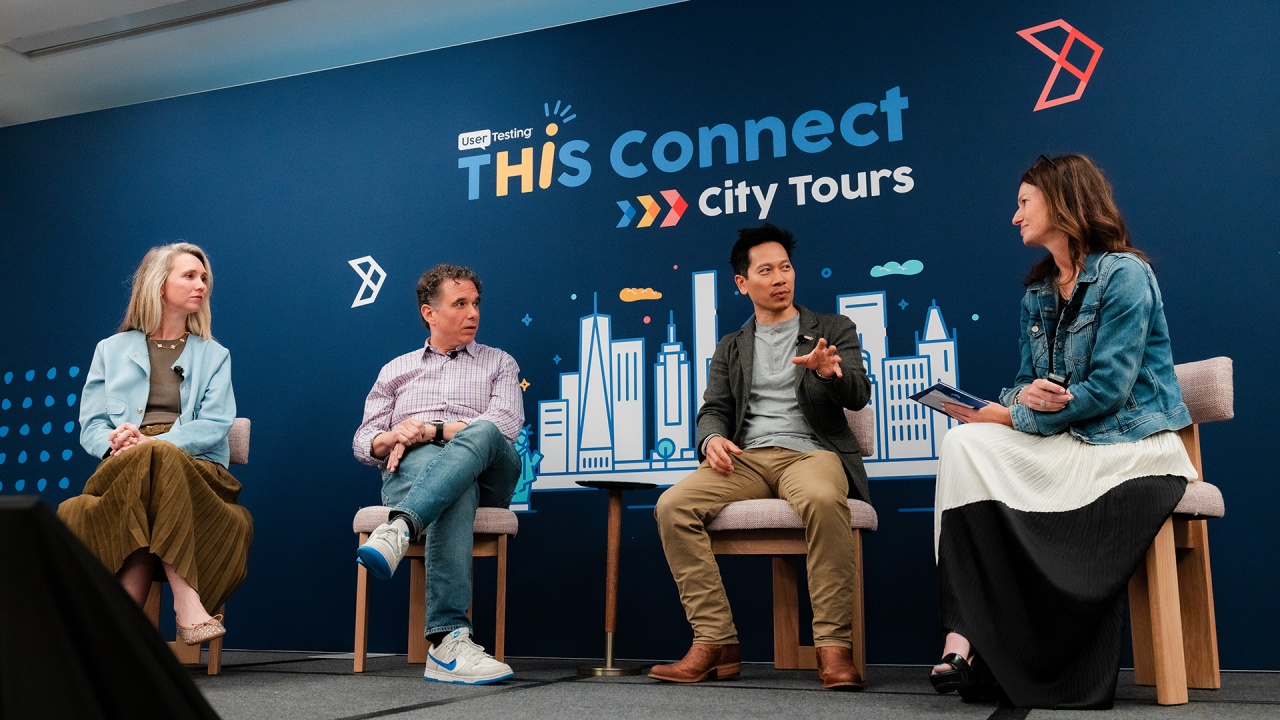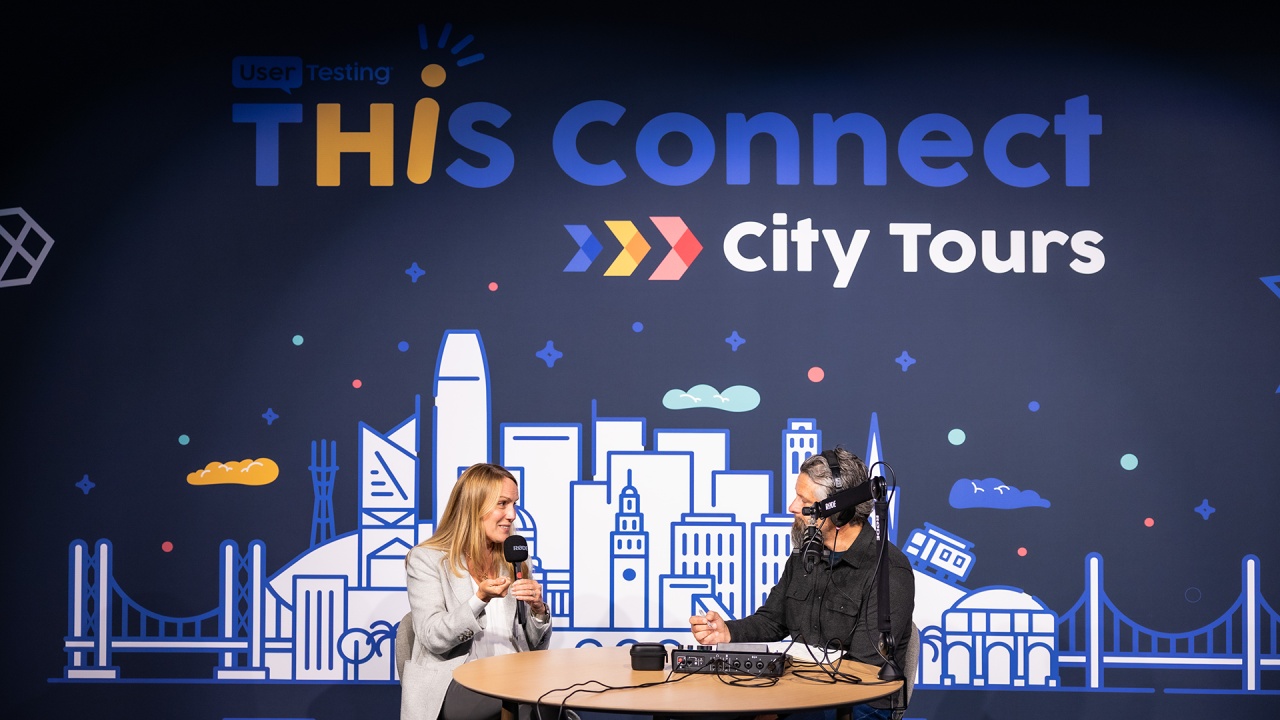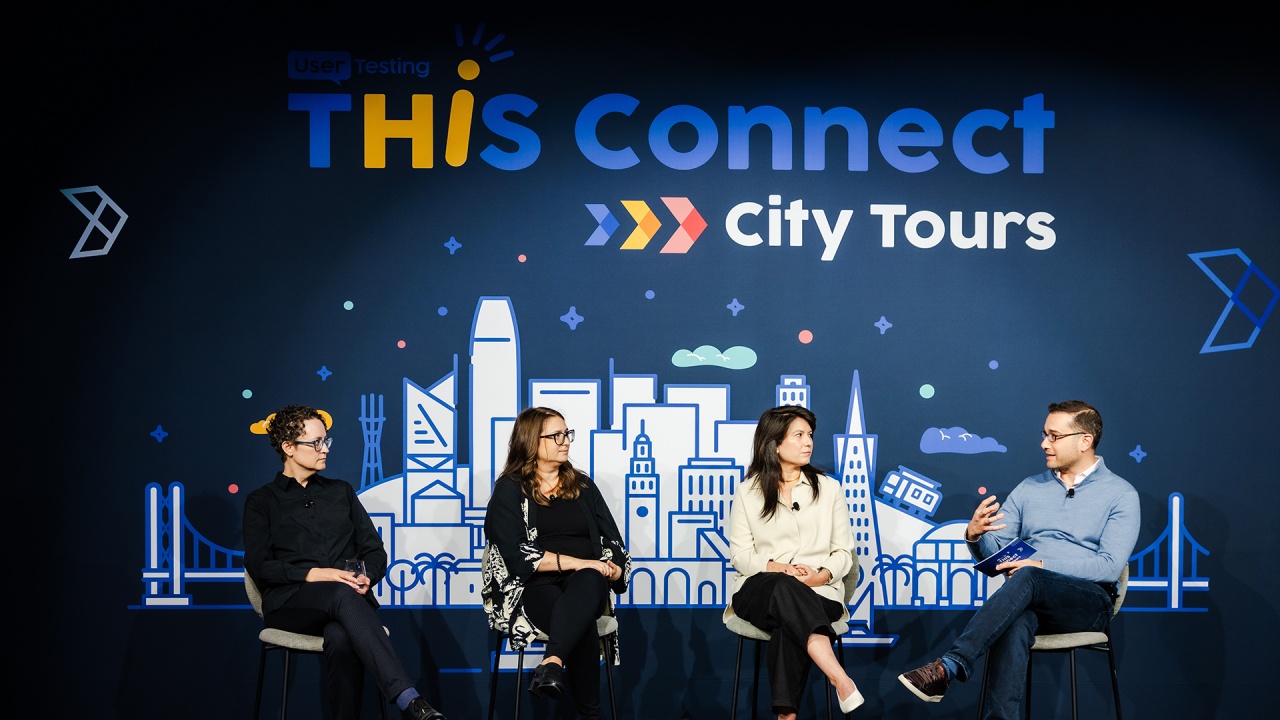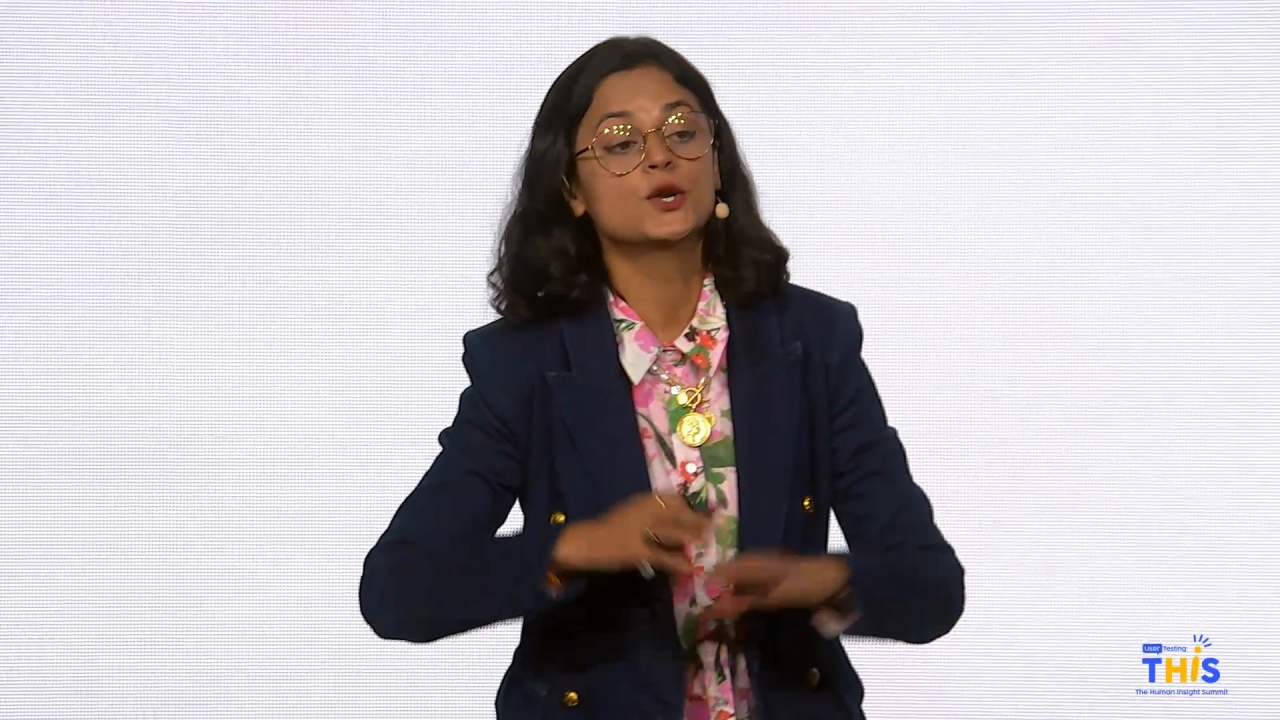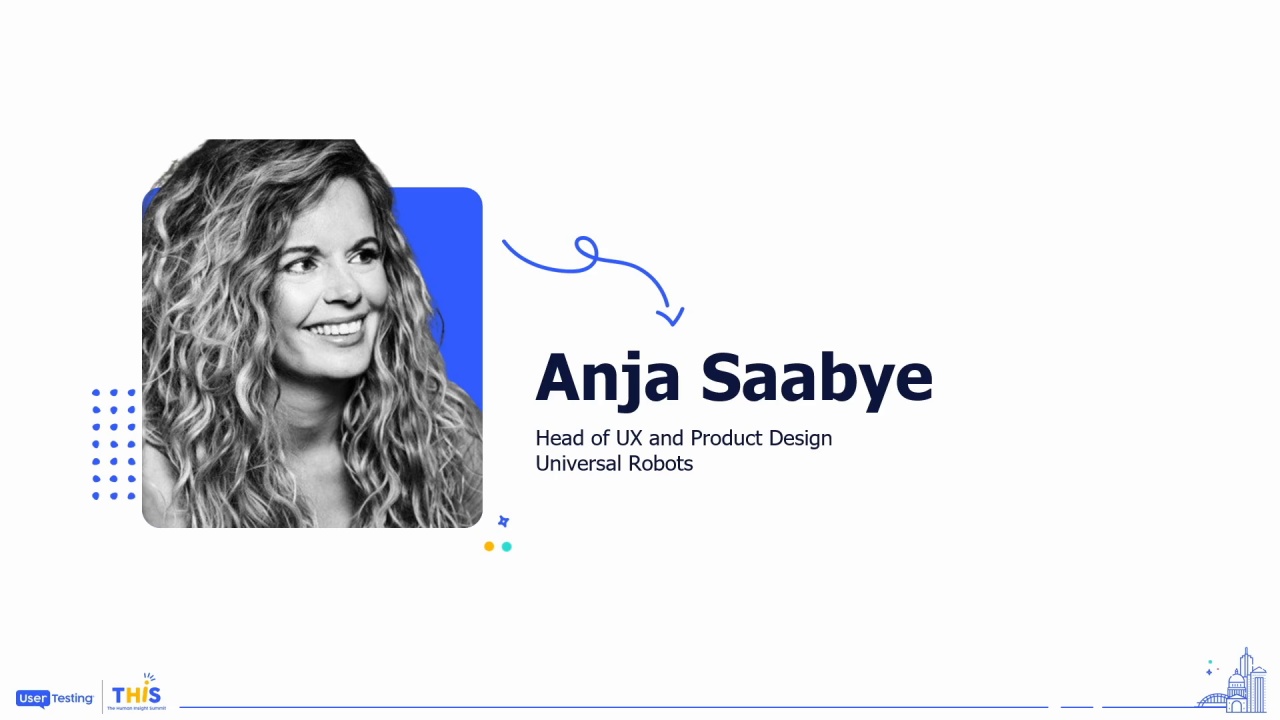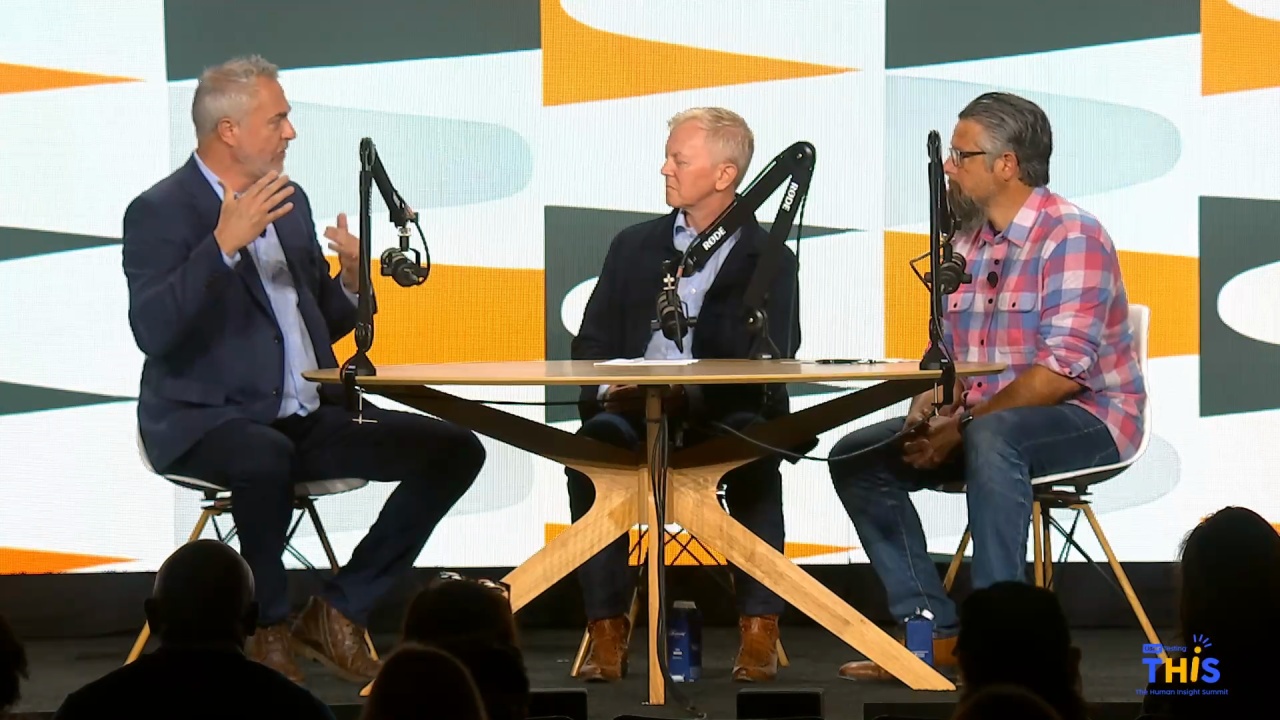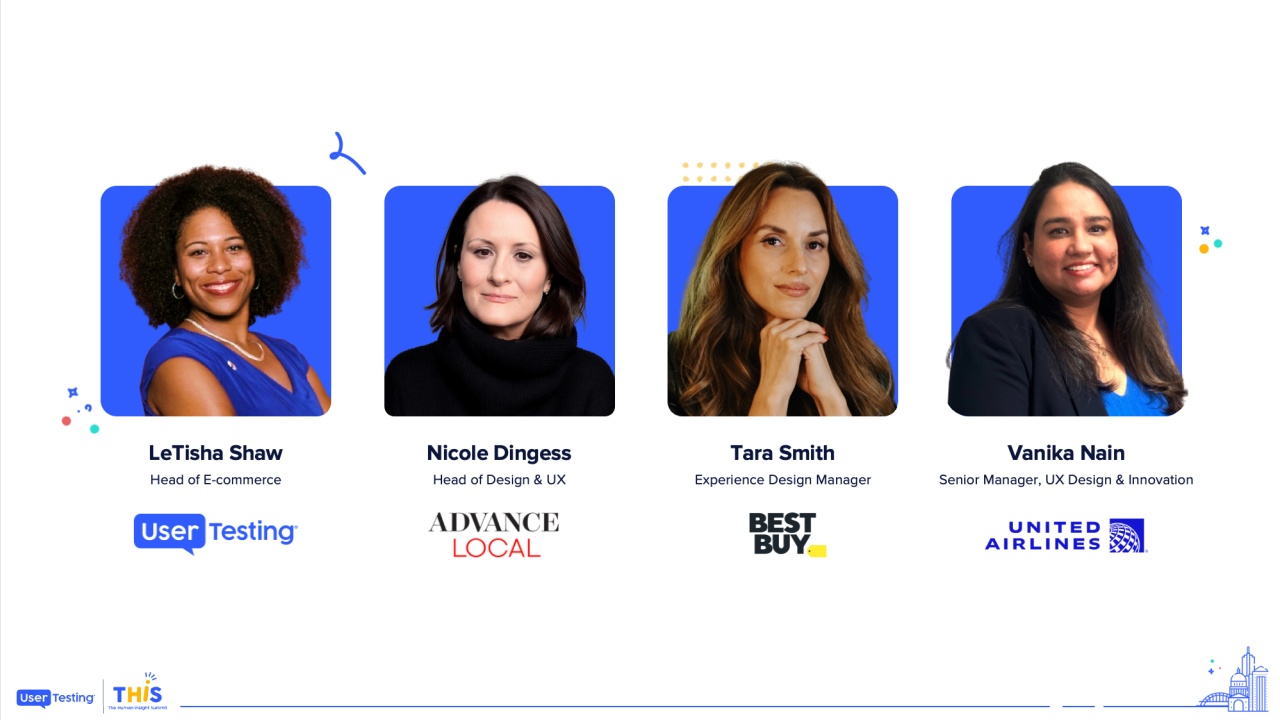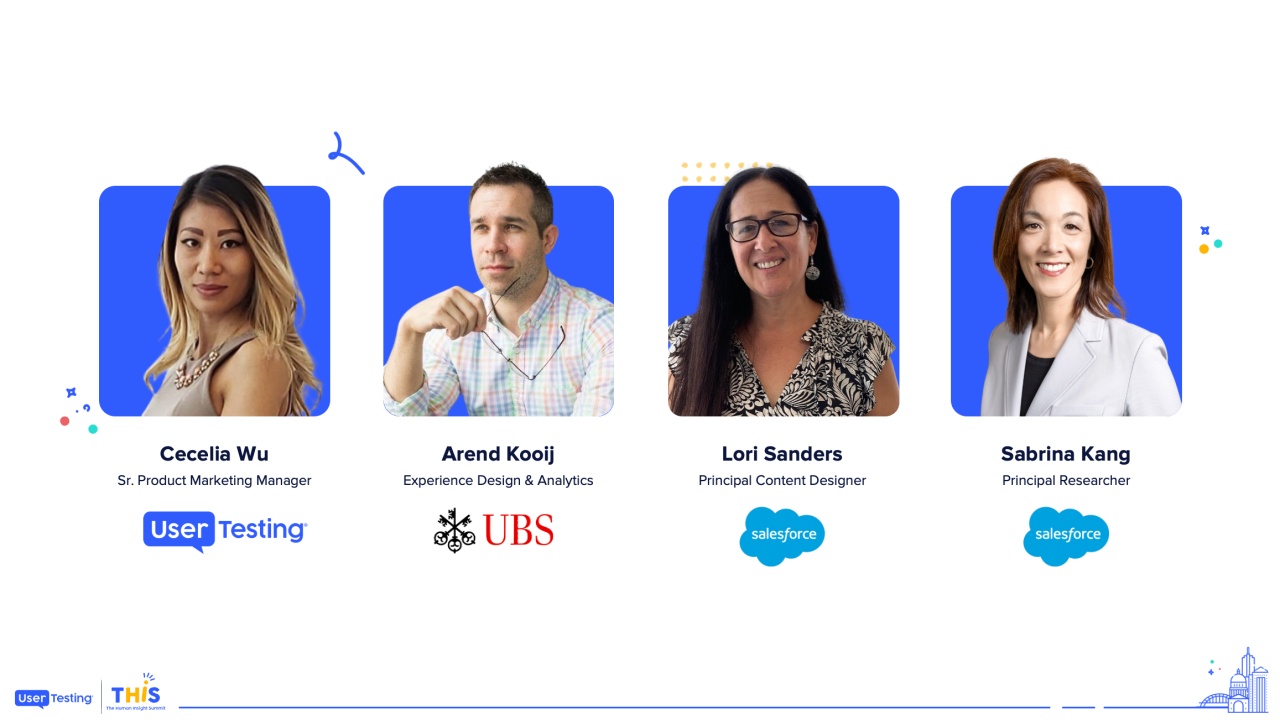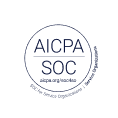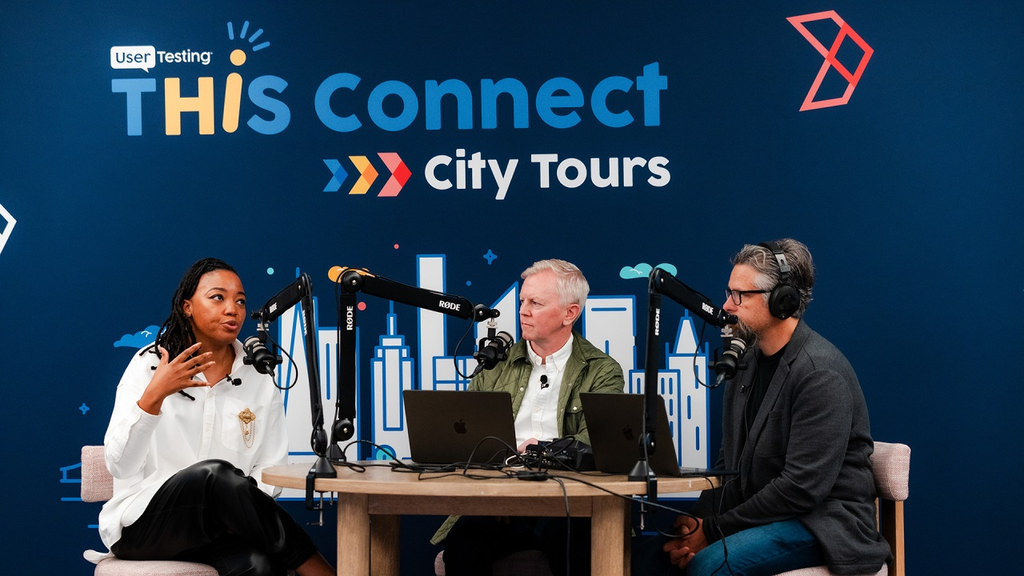
Live Podcast: Fearless by Design: Driving Innovation with Confidence
Aarron Walter
Host, Design Better Podcast
Elijah Woolery
Host, Design Better Podcast
Shani Sandy
Vice President, Experience Design, IBM
This live podcast episode explores how AI is reshaping the creative process—and the evolving role of designers within it. Shani Sandy, IBM’s VP of Experience Design, discusses the importance of trust, transparency, and co-creation in building user-centered AI. She emphasizes that designers must actively shape these tools, not simply adapt to them. As job roles blur and technical demands rise, the conversation highlights the growing value of hybrid skills and critical thinking. Human-centered design, Sandy argues, remains essential in guiding AI toward meaningful, responsible impact.
Maybe you've already heard, but we're in the midst of a significant global technological change.
It'll be a struggle for many businesses to adapt, but IBM's a company that's no stranger to change. Time and again, they've reimagined, restructured, and refactored their business to stay relevant.
Our guest today, Shani Sandy, is playing an important role in IBM's current transformation as vice president of experience Design.
Welcome to a live episode of Design Better and thank you for bearing with us through some technical challenges in the beginning. We don't often have to move our equipment between our home and...
Maybe you've already heard, but we're in the midst of a significant global technological change.
It'll be a struggle for many businesses to adapt, but IBM's a company that's no stranger to change. Time and again, they've reimagined, restructured, and refactored their business to stay relevant.
Our guest today, Shani Sandy, is playing an important role in IBM's current transformation as vice president of experience Design.
Welcome to a live episode of Design Better and thank you for bearing with us through some technical challenges in the beginning. We don't often have to move our equipment between our home and other locations. So still getting used to that.
We're so welcome to this episode of Design Better recorded at disconnect presented by user testing in New York. We are talking with Shani today about how her team stays connected to users to design great products, designs role in the new era of AI, and how IBM is evolving evolving.
This is Design Better where we explore creativity at the intersection of design and technology. I'm Eli Woolery.
And I'm Aaron Walter. Shani Sandy, welcome to Design Better.
Thank you, Aaron. Thank you, Eli. Thank you. User testing. Thank you, everybody.
So here's some irony for you. Shani, we met you at another live event in New York a year ago. Yes.
And and here we are again.
And here we are again.
You're only a great people to ask a question.
I do.
So that's a lesson for you out here.
If you ask a question, you might be on the show.
It might be on the show. And it I think it was an AI question, wasn't it?
It may have been.
Sadly, yeah. I didn't mean to bring that up then, but it's back at it again.
Oh, guess what?
We've got some AI questions for you.
Okay. Okay.
I guess it's it's compulsory.
Talk talk to us a little bit about how your team's workflow is changing. So you lead a team at IBM, a user experience team. You've kind of shifted roles recently.
Mhmm.
How is AI and the various tool sets that are emerging? How is that changing the way your team works?
Yeah. You know, I'm of two minds with this space.
Yeah. I'm I'm both optimistic about the tools and the ways in which it'll help us do our work better. Mhmm. And, yes, be more productive, also be more creative.
I'm also mindful that each person has to kind of charter their own path with their comfort level Mhmm. And what agency they still have and what agency they give to these tools. Right? So I, candidly, haven't been pushing as much as I think some other leaders are around you must adopt this AI tool.
I've been more so pushing our critical thinking when it comes to the AI experiences we're designing. Mhmm. So what we're finding is that there's this design with AI, which is the the former piece of, like, how we're incorporating our tools into our workflow.
And then there is design for AI, and it's us as designers, as researchers, thinking about what are those AI experiences look like in a way that still centers the user.
And so that latter piece is really where we're spending more of our time. But I will say that I think in the second half of the year, we'll probably get more rigorous on how we're incorporating the tool sets into our workflow.
I just think for for my point of view and the kind of work we do, which I'm in the I should mention, I'm in the business where we do support and services of our hardware and our software.
So this is a twenty four seven, three sixty five. There's no rest. If something happens with one of our clients' environments, we have to be there. There's no, oh, it's the weekend.
Mhmm. That doesn't cut it. And so I think because of the type of work that we do, it's been extremely important to make sure that the uptime, availability, resiliency, all these all these factors that our clients count on us for are even better. So that means bringing designers into that work.
So that's why I've been pushing more in that space as opposed to workflows and tools.
Yep. Makes sense.
I mean, give given that I I mean, actually, has a quite a long history with AI Yeah.
And, you know, with Watson and other projects like that.
Yeah. Deep Blue with chess and Yeah.
Yeah. Absolutely. Jeopardy?
Jeopardy. Yeah.
So given that, I wonder if I We're back.
You're back.
It gives you sort of a longer term view of these technologies and both sort of their their potential and limitations as you're designing products with and for them.
It does. I think so. You know? And it's great because it's a room room full of researchers and designers.
Right? They you all know your stuff. And I think the difference now, though, in the work that we're doing, we we very much always focus on kind of the three areas of desirability. Is this something that our users actually want?
And doing the research around that usability, of course, understanding that what we're creating has to be usable and in a way that folks actually enjoy it, so the delight piece. So those three pieces don't go away. There's still dimensions we care about. I think what's different now is, especially with these AI experiences, can we create experiences that people trust?
Like, I think this is now the new paradigm that design is in where what the outputs are that a user can get, frankly, shouldn't be trusted.
Right? So designers have to figure out how to put into that experience, how to put into that engagement guidance or cues to help us build greater confidence around what we're getting from these these AI, assistance or agents or tools. And so I think things like, you know, one thing I've been very kind of adamant about with my team is not just saying we're gonna create an AI tool or an assistant, really asking first, like, what is the question? The question is, what's the human problem to be solved?
That's the first question. That does not go away. And so I think for all of us in the room, we're gonna go through waves of new technology. AI is a thing right now.
What do you think it's hyped in now? It's real. It's now.
So our question still remains, what is the human problem to be solved?
Dot dot dot, how may AI help solve that problem?
And I think when we come to the table with that framework, it allows us to still tap very much into understanding our users, their their challenges, their motivations, getting very deep into that space before we start to slap on, here's another AI thing.
You know? So I I think that's a space that I'm still deeply committed to, especially because of the type of work that we do where we're trying to help our teams, particularly our, support agents and then our clients be able to do their work better.
Right? AI can do that, but it's not the fundamental answer each time. Sometimes, like, the process is broken. Right?
Unless you actually gotta revisit the process because you realize the process steps are actually the foundational ways that we get things done. And if the process is broken, applying AI to that doesn't fix the problem, now does it? Right? It might it might make it seem like it does temporarily, but it actually fundamentally doesn't.
So for me, going back to the question, what is the human problem to be solved for which AI may be the solution, is is a framing that I like to bring up anytime possible. Seema's probably sick of me saying that.
But I I like this idea of bringing it back to the human Yeah.
Because we think about, you know, this relationship to human and machine, and we've gotta figure out what our relationship is and the idea of trust. Because trust, I think, for a long time has been a pretty significant issue.
All of us here have lived through this very optimistic pre social media, kind of the ecstasy of, like, we're creating great things, they're going to change the world.
And yes, it did change the world but in a lot of ways that we didn't expect or intend.
I'm curious how you, you know, I can't help but bring my own skeptical view on awesome AI. I'm I'm optimistic and hopeful and, you know, been burned before, don't wanna revisit those those bad outcomes.
How are you thinking about trust? How are you thinking about designing for trust? How are you getting the insights about your customers to know where they are mistrustful or where things fall apart?
Yeah. Aaron, I'm I feel very much like you. I'm quite ambivalent in this space because I think, of course, there are benefits to to to to technology. In this case, we're speaking specifically about AI. And oftentimes, automation, that's also a part of it. But, I think that the downsides, frankly, are underplayed.
Mhmm. And I think that for us, particularly those of us in design, I I really think our work is to strip off a lot of the layers of the seemingly exponentially amazing technology that we all now you know, if we're in certain rooms and spaces, we all now have some form of access or familiarity with and really get at the deeper root of the consequences of technology.
So if we're supposed to be the ones that understand our users, if we're supposed to be the ones that advocate for our users, then that means that as we're designing these experiences for our users, we need to be thinking about what does that look like for them and what are the potential consequences and unintended consequences. Yep. And so I think, you know, I I will I will definitely give a shout out because our IBM design team has done a a fantastic job with actually creating these principles around how do you design for things like trust. Mhmm. Right? So making sure that there's explainability involved when you're creating these AI experiences. So can you actually explain how the AI came up with output?
Can you design that? Can I see as I'm interacting with a with a with a assistant, how did you actually come up with this so that I know whether or not I can trust it or not?
Especially with the types of clients that we deal with, we cannot afford to put out information that is erroneous. And I think probably anyone in the room could say the same thing.
Things like having, you know, confidence ratings in the responses. So when a response is then, given to a user, they're able to see, okay. This particular response was was scored about eighty five percent. Right?
So that also is a way to imbue these these qualities. Okay. As a user, I can have a bit more consideration that this might be a more accurate answer. Right?
But you shouldn't take it off the premise of it's right because it came out of the machine. It's just what you you should not. And so I think these types of things as designers, as researchers, we need to think about how do we do this for our users and how do we also make sure that we continue to evolve those types of experience checkpoints because it's gonna change as the technology changes. Right?
So I I am I am I'm cautiously optimistic that many more designers and and researchers are thinking this way.
My concern is that technology is changing so fast, and it's hard to keep up. And so that's why I keep saying if we come back to, like, a very basic question of where is the human problem to be solved, I think that's a way to help calibrate us back to the humanity piece.
But I do think that there are aspects of this work that we're just still learning, we're still figuring it out, and we're trying to catch up sometimes.
And so that means that designing for trust is going to mean literally every time we're putting on experience, we have got to understand what that means for the user. Whether it's ethnographic research, whether it's qualitative research, quantitative, we have to get literally in the shoes of our users to figure that out. And we've, you know, we've done we've done that, within our teams and really shadow teams and are now putting in more behavioral analytics to figure that out. But I would absolutely say to each and every one of us who are in the room today, it is our responsibility to design for trust. It is it's not a nice to have in the kind of work that we're all likely now doing.
I think that trust thing is huge, and we run into it in our own work, maybe in the smaller scale way, and that occasionally we'll be writing an article and we wanna pour through, like, two hundred pages of transcripts and extract some themes and time codes from a certain episode. But I have to go back and check, did it hallucinate? Often it did. And then it tries to blackmail me.
Then I tried to shut it down and it won't shut down. So we run into all all these kinds of issues. But, you know, I I think for a company operating at scale where it's not just, you know, two people working on a podcast, but you're trying to stay connected to your users and sort of assess their level of trust. You mentioned ethnographic research, but are there ways or can you go deeper on that, or are there other ways you stay connected to your users?
Yeah. So last month, our team had a gathering, in person, an in person gathering.
And and, as part of the gathering, it was really primarily around us as a team getting together and forging certain principles around ways of working for our team and with our cross functional team members in development and in product.
But it was also an opportunity to be on the ground with our users and do cocreation sessions with them.
And our users are you know, they run the range. So the internal agents who are dealing with support cases in volumes that are just unwieldy sometimes, And then there actually are clients who have issues and are coming to us to get their issues, addressed. But we're also looking at doing things in a preventative way so they're not having to come to us for these issues. Nevertheless, one of the things we did is I I was adamant that once we're there, we have to carve out time to meet with our end users and conduct a session with them around their needs. So we did need statements. We did empathy mapping. And we just, like, connected with our folks and understand what a day in the life looked like for them.
I know that was the first time that ever happened.
Now it won't be the last, but it needed to happen. And so I think these types of things, I'm definitely a fan of, like, hybrid ways of working and and different approaches.
However, you cannot replace the, kind of in person nuance look on people's faces that maybe way they may reserve some of the comments they want to make because of the the impact or the the the consequences it may have.
Maybe the things that you see someone in the corner who's quiet and you're curious to hear what they have to say. These types of things we're able to get out when we're in the room together with our users.
And so I think those are ways in which bringing our users into the work and not in an extractive way. I have to say this. I think sometimes in our profession, it's like, okay. I need to do some user research research so I can validate x y z. That that's that's extremely extractive, and I and I and I don't care for that approach.
And so whenever possible I know it's not always possible. Whenever possible, we can do this in a cocreative way. That's my preference.
And and and I will say, you know, my first few months in in the role that I'm in now, I shadow people. Like, I went on-site visits and with one of our agents who's in the field, like, changing hard drives and and fixing, you know, the different parts of the the the client data center.
And Jess was an observer.
Right? And and so I think wherever we can do more of that, it it builds a deeper appreciation of the work and then bringing our users in to do the cocreation is there's no replacement for that.
One fascinating thing that we're seeing as a as a theme as we talk to more and more teams, is that there's this, blurred line between disciplines.
So the phenomenon of working on very complicated things like we all work on, it requires a lot of specialties and deep knowledge and expertise.
With that deep knowledge comes its own specialized language. As we have more specialized language, it is harder to communicate and we have different value systems, engineers, designers, etcetera. There's different value systems and sometimes those collide in very uncomfortable interpersonal ways that work. I'm sure everyone here has some story like that.
But one thing that's really interesting to us is that we keep hearing designers say, hey, I can do this engineering stuff now, I can vibe code some things Mhmm.
To prototype very quickly, and we're hearing engineers say stuff like, hey, now I can design a UI and get pretty close pretty quickly, And I can't help but think that we are accidentally creating this brackish water between our teams where there's this opportunity for us to understand one another in in new ways. Is that something you've seen?
It resonates. It resonates. I you know, I think that it's okay.
I think it's okay that this the the the lines are blurring because I think the type of work we're doing now is work that is so multimodal. It's so it's it's moving at a again, in a clip that's so unwieldy that you need that cross functional, cross hybrid, multi hyphenate type of person. Like, I think just to be in one lane, frankly, and just to have that specialty, it's it's limiting in the type of experiences that need to be created. So I think that, it's uncomfortable.
It's uncomfortable. I think there's a feeling like, oh, that's my turf, and now, you know, a developer is is doing something that they did in Figma, and now they have, like they think that they can design and etcetera, etcetera, right, or vice versa.
But I do think it's the way of the future where we're gonna have more folks who are just multi hyphenate in their professional role. And I actually think it's healthy because it reflects the multi hyphenate ways that we're, like, living and working in the world. Right? You know, you wake up in the morning, you might look at your phone, and then you look at your laptop, and then you're off. And you might look at your, you know, your watch and your wrist. That's like, you know, checking your biometrics, and you're still in the world, and you're still living. You're having environmental experiences in spaces and moving throughout space.
And so I think that just the reality is that our modalities are just more and more evolved and will be more and more varied. And so to me, then professions should just reflect that. So it's gonna be uncomfortable, but I think that if you're if you want to remain engaged, you should consider being a bit multi hyphenate.
Yeah.
You know, it's interesting in the in the prior conversation, the panel before, there was a comment about, you know, being digital native or not being digital native.
It feels like we're AI creates this opportunity for us to be native in almost any discipline Uh-huh.
You know, if we wanted to be.
Uh-huh. Yeah. I mean, I I know I'm probably gonna screw this quote up. But the the there's kind of this I'm sure, after I say some first of all, someone told me if I screwed it up.
But the idea is that, like, the AI we're experiencing today is the worst AI we'll ever experience. Does that sound familiar? Well, that's what they're saying. Because That's true.
Right? So so I think I think that's exactly right that, they were kind of all in it. We're all kind of figuring it out as we go. And, you know, as the weeks and months progress, the technology is changing.
Right? Just what? Just this past weekend, the VO was released, the which is the ability to to use text to generate video. Yeah.
Like, really legit. You're a pretty legit video.
And, I want to play around a little bit, but I'm not subscribing a hundred fifty dollars a month for it. So that that'll have to wait. You know, I'll be second generation.
But these types of things are are happening in real time. Right?
Yeah.
And and I say that a little bit, you know, facetiously too about the about the cost because in reality, not everyone is having access to these tools. And so there's another piece of this not suggesting that this has to be the space for designers, but I am suggesting that if you care about, users and democratizing access that, you know, that's another space we might wanna consider playing in or understanding how can the access to these types of tools be made more accessible to more people.
Because right now, frankly, if you wanna play around with it, just maybe a tool set of three, I won't name names, but tools set of three, You're gonna pay a couple hundred dollars a month Mhmm. For that on top of just anything else you have. Right? So I do think there's part of this that is a conversation that's privileged in your ability to access these types of tools.
So in addition to the kind of multidisciplinary changes that are happening and roles collapsing or the types of things you're expected to do expanding, it's kind of a it's a tough environment out there for folks that are maybe looking to change jobs or find a job. We we do a survey every year, and the forty one percent of the respondents this year said that their biggest challenge was finding work or finding new work, not necessarily maybe a job that they wanted more. If not, they're not out of work. But in in any case, career is a top of mind.
Companies are tightening their belts. Folks are looking for jobs. And my class I teach graduating seniors, and this is the hardest job market that they've faced in the thirteen years I've been doing it. I'm just curious. How does this sort of, you know, shape the work at IBM and and the team your team, and how how how is it affecting you all?
Yeah. I I first, I wanna recognize that sometimes I will add to that.
Friends and colleagues that I have been talking to in the last few months, especially, who are looking for work, have expressed how just darn hard it is. Like, it's just tough right now.
And it's not a reflection of people skills. Like, it the the reality is that places are not hiring as much anymore. And the rub is you have these amazingly talented people in the marketplace that aren't able to find the right opportunities.
And so I think about this in several ways. I think and I could talk a bit about what, you know, what we're doing at IBM and just my thoughts on this generally.
For me and my team and also from an IBM point of view, there has been a lot of focus on gaining the skills, gaining particularly the skills around AI, understanding data and data structure and architecture, understanding the basics of what it means to build for AI.
I think we all need to understand that. It doesn't matter what role you're in. I think it's important to have an understanding of what that world looks like in terms of when people say our AI, what they actually say versus what it actually means.
And having enough ability to call BS when people say things is hugely, hugely empowering. So I think just for your own, benefit, that that's important. So I think, you know, yes, acquiring the skills is is gonna be important. What skills does that look like, though?
I think a lot of folks talk about prompt engineering and how you have to be the best prompt engineer, and that's gonna make you viable. I think there's validity to prompt engineering, but frankly, like, AIs can now create amazing prompts. So, like, okay. So you learn how to prompt engineer, and now, like, an AI can do it.
So I think that to me, what's more foundational or maybe a return to is the so called, like, interpersonal skills. Sometimes people call them soft skills. I don't like that term, but I'll use it because I think when you say soft skills, people will know what you you mean. But I think these are the skills around being able to communicate in ways that are compelling, being able to convey your message, being able to negotiate, being able to collaborate with teams that are going to be more and more increasingly increasingly diverse in role types.
Right? Now we work with linguists and data scientists, not just developers and engineers and product folks.
So I I I my read is that what we've been doing within our team is thinking about how to, yes, do the technical work of building these AI experiences, but also, like, what are the soft skills we need to also be able to to develop and advance in the in the world and the way it's changing right now. And I think for folks, like, looking for work, you know, first off, like, wherever you can help folks, that that's that's the place we should be in. That's the gap we should step into. Like, talk to folks who are looking for work.
Be there to say, you know what? If something comes up, I'm gonna I'm gonna put your name in first, or I'm gonna, you know, make sure that, you know, I connect the dots to someone I might know. I think now is the time to, like, really dig deep into community and for each other for each of us to help each other, especially when we're in situations, where we're looking for work or wanting to make a career pivot. And I think the last two things I definitely wanna say on this topic because it's such a it's such a big one, and there's so much more to talk about because of how much it's impacting professionals across the board.
I think one, I would love to see more designers go into, like, the space of, like, building these AI companies because I think there's, again, a gap. I I I think, what is it? Like, pie pie was one of this. It was supposed to be, like, a personal assistant that had emotional intelligence.
Right? Like, I don't know how well it caught up because I I stopped using it. But but I I think, like, I would love to see folks who are, again, focused on understanding users, understanding human behavior, and having those folks really get into worlds where they're founding these businesses. Because I think they're gonna bring a different lens that's missing to to to the to the space.
And I think the last thing is, like, maybe it's a time for the overused word pivot. Like, it might be time to say, you know what? I'm not really finding the thing for me, or I hear all about this AI space. Okay.
Cool. I know about it, but I don't wanna go all in.
So maybe it's time to pivot into some something entirely different that you put on the back burner, but maybe right to do Aaron's thinking about becoming a baker.
You're not trying to, you know, not.
Listen. Listen. Baked goods are my like, baked goods, done.
Everybody always wants that.
Talk about putting the human back in the technology.
You you got it. You got a customer right here built in. Yeah.
I like what you're saying about, you know, helping people out to find work.
And just a a quick plug, design better dot directory, there's a ton of talent there. Very talented experienced experienced people if you're looking to hire.
And if you have job openings, same place you can post your job openings for free.
We have had people hired off.
Yeah. Yeah.
So as we wrap up here, I'm curious, you've got your you've had an amazing career and you're doing a lot of interesting things at IBM. What are you most proud of from what you and your team have done?
There's so many moments. There's so many things. I guess I'll just use the most recent example because to be fair, there are so many proud moments.
But I had shared that last month our team was doing a gathering, and, it's a newly formed team. So there are some experienced folks, but some folks who are brand new. And we did it in, Sofia Sofia in Bulgaria.
And, we had a three day session.
And the second day, guess who gets food poisoning?
Oh. Yeah. Yeah. It was me.
No baked goods.
No baked no baked goods. And so, I was done. Like, I I didn't even know if I could make it through the rest of the trip.
And so that Wednesday, I let my team know, you know, I'm not feeling so great. Let's touch and go. I'll see how I'm doing in the afternoon. But it was like, I I'm here.
I can't not figure this out. Like, I gotta figure something out. So I was doing everything I could to get better. Eventually made it to the office that afternoon.
Again, nowhere near a hundred percent, but did did the best I could. And I got there, and I was like, they didn't really need me. They did an amazing job. Right?
They you know, we were second day was all about it was actually I was leading the second day and revisiting our retrospective around, areas that we wanted to improve on, what are some of the solutions we could create to address those problem areas, and had an entire kind of program around what I wanted to make sure was accomplished. And I got there, and they just did it. They led, and they made it happen. I came in, and they were already thinking about solutions and owners and, you know, how they would approach the the the challenge space.
And it's it might sound like really like, oh, that's that's what you're most proud of. Like, that seems just, like, normal or small. But what you have to recognize is, like, this is the first time meeting in person. I just hired half of the team.
It's a very, very small team. I just hired half of the team a few months ago. And so the very fact that they just assembled themselves and figured it out, to me, was was reflective of them understanding that they have as much ownership in where the team goes than I do. Mhmm.
And that was, like, icing on the cake for me. So I think that would be it.
Kind of a good leader.
Yeah. Thank you. Thanks so much.
Shani, thank you so much for being on Design Better.
Thank you for having me. It was way too short.
Next time, we'll have to do a part two.
Part two. Okay.
Thank you also. We are in the lucky position of opening for our next act, the wonderful Seth Godin. I'm gonna tell my kids, they're not gonna be as impressed because I have a friend that opened for Nirvana in the nineties, and I don't think I got curious quite the same cache. Sorry, Seth, but we will transition over and move our stuff off stage and get ready for the next guest.
Thanks, everybody.
